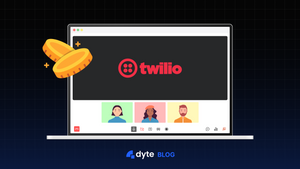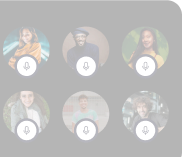For what started as an API for automating traditional phone calls and text messages, Twilio is now a formidable player in the video SDK space providing programmable APIs allowing developers to integrate audio and video onto their platform.
However, Twilio is sunsetting their Twilio Video, we've already had multiple customers migrating from Twilio to Dyte, so if you are looking for a Twilio Video alternative, check out this in-depth comparison between Twilio and Dyte.
When you're considering integrating an audio-video SDK into your system, issues surrounding compatibility or other challenges may be your initial focus, depending on your tech stack and engineering bandwidth. Twilio is a top contender in the video SDK space that has been around since 2008 (until they rolled back Twilio video in December 2023), particularly evolving to provide business communication that you can integrate into your applications.
While Twilio is a popular choice because it is a legacy contender, it's not the only one available on the market anymore. Several other video SDKs offer similar features and may better fit your needs.
Here are some reasons why Twilio may not be the right choice for you:
- Twilio’s video pricing can be expensive, especially for high-volume usage.
- It can be complex, requiring multiple SDKs for calling, streaming, and more.
- Integrating Twilio requires high coding effort.
- Streaming out with RTMP is not available.
- It offers limited roles of host and participant and thus cannot be customized to the use case.
The pricing decision
When selecting an audio-video SDK for your needs, its features are essential, as well as the cost it comes at. This is where pricing becomes crucial in ensuring that the price is not prohibitive for you. Being a legacy player, Twilio provides most of the core capabilities, even if it requires high coding effort.
While different video SDK providers charge on various metrics, Twilio's video pricing is calculated based on usage. More specifically, Twilio video pricing is based on price per participant minute — or the number of minutes a participant spends in a room and the number of participants part of the room.
Twilio isn't particularly easy to integrate, and the costs also do tend to stack up — particularly in cases with an increased volume of usage.
Understanding Twilio video pricing
1. The trial period
Before we get into the nitty-gritty of what is on offer and what you are signing up for, let's talk about the trial period itself.
Twilio doesn't offer any free minutes or a trial period and requires customers to start paying upfront for the services they use.
💡With Dyte as your video SDK, you get 10,000 free minutes each month.
2. Video and audio
Being the most fundamental feature, Dyte and Twilio go head-to-head when it comes to pricing for video. Both charge $0.004/user/minute for video.
The difference comes when it is audio, as Twilio's video pricing makes no differentiation when charging for audio and video, which is a flexibility that Dyte offers you.
💡Dyte offers pricing for audio at $0.001/user/minute, while Twilio remains at $0.004/user/minute.
3. Support
For a developer-friendly experience, it's crucial to have reliable, comprehensive, and proactive vendor support throughout the integration process. Further, it is also essential for deploying and implementing features across various customer environments.
Twilio's support is based on the volume of usage, and it has four different support plans — Developer (free), Production (paid), Business (paid), and Personalized (paid). The response time decreases for every subsequent tier while the costs increase.
For the Personalized plan, which is the highest tier, costs can range to $5,000 or 8 percent of your monthly spend, whichever is higher.
💡Support on Dyte is free for all customers and available 24x7.
4. Analytics
For any video SDK you choose, monitoring the usage and quality of performance is imperative to solve any problems that may arise.
Twilio offers data retention for 14 days and seven days for rooms and participants. While data is available beyond the time limit as well, it is not filterable. If your use case also requires analytics, Twilio levies an additional charge.
Analytics over this data is available, but Twilio charges for it.
💡Analytics is available, accessible, and free on Dyte.
5. RTMP Streaming
Streaming out with RTMP is not an option Twilio offers, while HLS streaming requires manual configuration.
💡Dyte offers RTMP streaming, available at $15/1,000 minutes for HD video.
6. Recording
Having recording capabilities is an essential tool in your arsenal and is critical to consider when deciding. If your use case involves a lot of attendees and the session is being recorded, the charges may compound quickly.
Twilio video pricing accounts for recording based on participant minutes and not minutes recorded. In this case, participant minutes would be individually calculated depending on how long a participant has been connected. For recordings, Twilio charges $0.004 per participant minute (NOT minutes recorded overall), as well as $0.01 per minute as composition charges.
💡Dyte offers a simple solution at $10 per 1,000 minutes recorded.
7. Storage
Twilio offers 10 GB of free storage, and as per Twilio’s video pricing, it is chargeable at $0.05 per GB per month for additional storage.
💡The first seven days of storage are free on Dyte, following which it is charged at pass-through AWS rates of $0.023 per GB per month.
8. Missing features
Twilio does not offer chat, screen share, whiteboard, audio rooms, plugins, polls, breakout rooms, or a media player as part of its SDK. Additionally, Twilio's video pricing doesn't offer dedicated discounts if your use case involves high-volume usage.
💡All of the above features are live on Dyte. Volume-based discounts are also available.
End note
Apart from staying true to its developer-friendly nature and allowing quick integration, Dyte offers easy customization and extensibility. It provides a hoard of user-friendly features you would expect from a video platform, such as virtual backgrounds, breakout rooms, chat, polls, analytics, and more.
These features make Dyte a powerful and versatile video conferencing platform for you to choose from, which can be used for various purposes and tweaked to suit your needs. Whether looking for a way to connect with your team, collaborate with clients, or deliver training, Dyte could be the last stop in your search for the perfect video SDK.
Create exceptional video experiences with dyte.io’s feature-rich and developer-friendly video conferencing solution.



